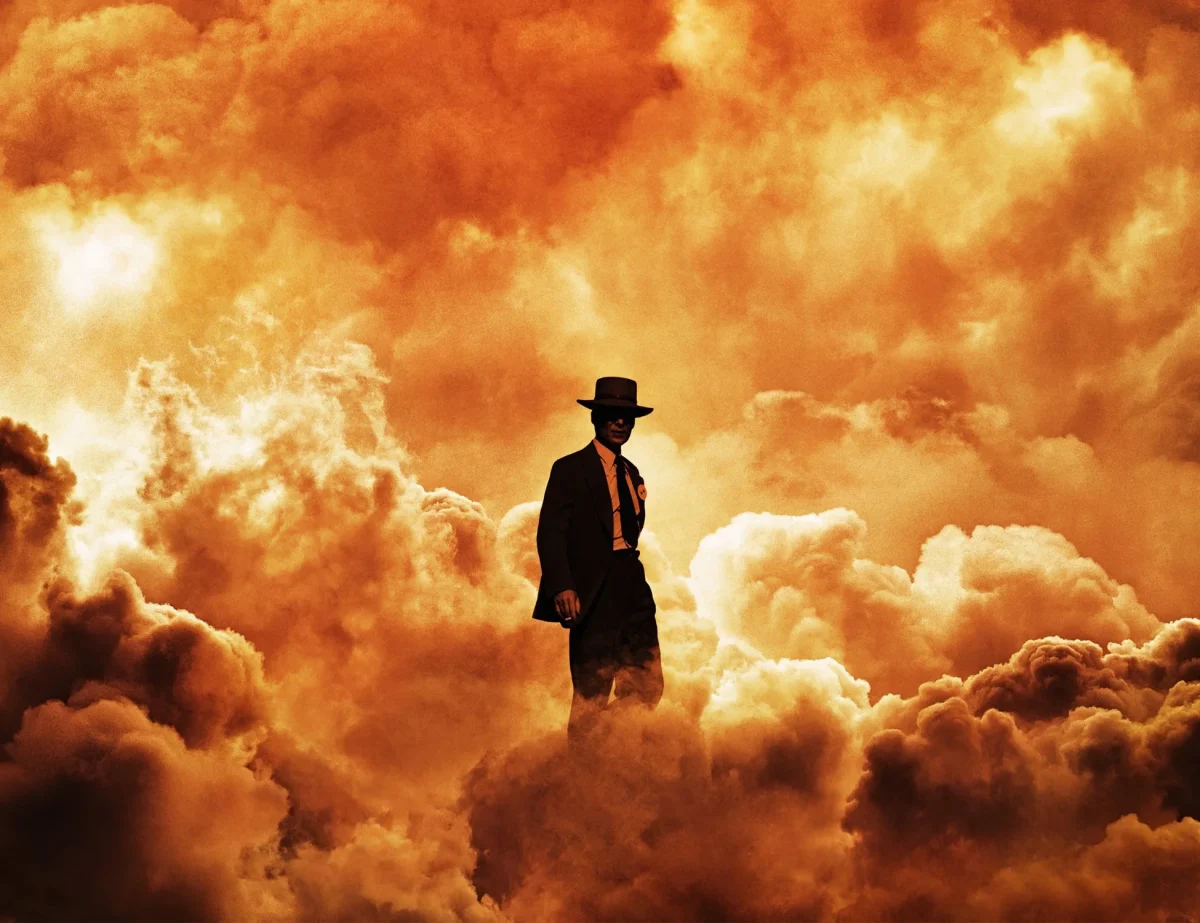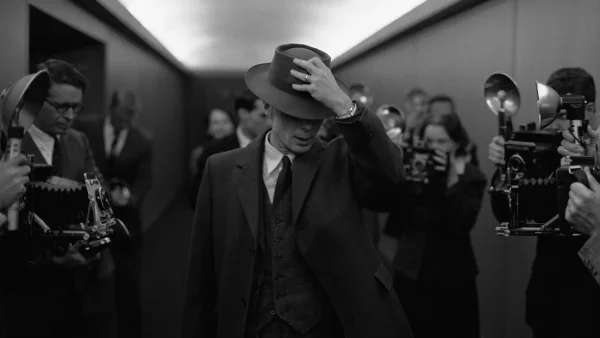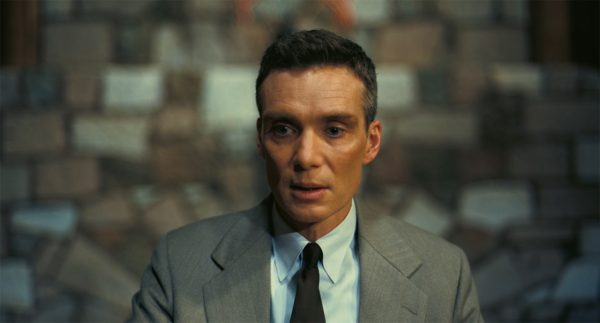
An image from "Oppenheimer"
It’s scary to see the ghost of Robert Oppenheimer haunt cinema’s pioneer purist. Considering the context, the circumstances surrounding the making and release of “Oppenheimer” made the film into Christopher Nolan’s Manhattan Project.
During the Second World War, J. Robert Oppenheimer was enlisted as the head of the Manhattan Project. He recruited some of the world’s top scientists, all of whom worked in tandem at Los Alamos. The stakes were immeasurable. In case he failed to build the bomb, 20 kilotons of TNT would be put to waste, and Oppenheimer would lose his credibility.
Christopher Nolan went through a similar ordeal. After his action flick, “Tenet”, caused clashes of creative visions, Nolan ended his long-standing partnership with Warner Bros and signed with Universal. Here, he gathered one of the most powerful casts in recent history. The stakes were immeasurable. In case the movie failed, almost three miles of IMAX film would be wasted, and Nolan’s future in Hollywood would be on the line.
J. Robert Oppenheimer went on to successfully build, detonate, and reproduce the world’s first atomic bomb. The dropping of these bombs on Hiroshima and Nagasaki definitively ended the Second World War. Christopher Nolan’s “Oppenheimer” turned a massive profit at the box office, secured an impressive awards haul, won over the critics, and reclaimed his Hollywood crown.
Last week, I had the opportunity to revisit “Oppenheimer” after nearly a year. I think it still holds up to be one of the more thought-provoking and thematically important films of the last decade. Of course, there is little debate regarding its superiority over films as influential as Bong Joon Ho’s “Parasite”, which I consider to be above “Oppenheimer”. However, based on the thematic and narrative concerns of both films, I believe this is an unfair competition between two very different and unrelated movies. Both films had different objectives, and both fulfilled those objectives using different methods.
That said, “Oppenheimer” is an excellent film and worthy competition to the heavily acclaimed, generation-defining films of this era. A talking point worth mentioning is “Oppenheimer’s impressive award haul. I do not believe awards—even those as acclaimed and sought after as the Oscars—to be fair judgments of the quality of a film, but I do recognize these achievements as a marker of widespread impact.
Movie Review
Disclaimer: The following review contains spoilers for “Oppenheimer”.

“Oppenheimer” does many things very well, the most important of which is reclaiming Christopher Nolan’s crown. After “Tenet” underperformed and had mixed reviews, “Oppenheimer” is a true run to form for Christopher Nolan. Audiences and critics are generally not in favor of an R-rated film with a three-hour runtime. Therefore, “Oppenheimer” had the odds stacked against it, especially when it was such a different film than what audiences were used to seeing from Nolan. This makes the film’s success all the more impressive.
This is why I understand Christopher Nolan’s decision to make this film in the first place. By choosing such a thematic and narrative tangent from what audiences are used to seeing from him, he doubles down on himself. Nolan is infamously an eccentric film purist and a pioneer of the IMAX format. With his future at a dangerous crossroads after “Tenet” and post-COVID cinema attendances, “Oppenheimer” was his public reclamation of his principles.
It is also reasonable to suggest that “Oppenheimer” was a culmination of Nolan’s most polished tools. The film’s non-linear sequencing and split between colored shots and black and white shots is “Memento’s” signature. Themes of obsession and consequence echo “Inception” and “The Prestige”.

The film is wonderfully acted. Cillian Murphy delivers a standout performance as Robert Oppenheimer. In such a dialogue-heavy film, at times, the most talking is done by Murphy’s pupils. His acting justifies many shot-framing decisions. There are many extreme close-ups, all acted by Murphy’s subtlest facial and eye expressions.
Robert Downey Jr. follows impressively. His performance as Lewis Strauss imitates a boiling pot, dangerously close to full combustion. We see glimpses of this controlled intensity in subtle scoffs during an advisory meeting on the hydrogen bomb and his thunderous monologue during his confirmation hearing. The choice to portray Strauss as a man on edge is genius and looms over a paranoia throughout the film.
A shockingly impressive scene-stealer was Jason Clarke’s Roger Robb. As the lead prosecutor against Oppenheimer’s security renewal, Clarke’s constant intensity is the perfect contrast to Oppenheimer’s calm, regretful demeanor.
However, there is a reasonable argument against Nolan falling prey to one of his oldest criticisms: female portrayal. “Oppenheimer” underutilizes a strong performance by Emily Blunt as Kitty Oppenheimer. Amidst small hints of issues with alcoholism, postpartum depression, motherhood, and infidelity, there seems to be an entire story thread cut for the sake of the film’s desired narrative.
Florence Pugh’s Jean Tatlock faces an even worse fate. An acting powerhouse such as Pugh is wasted by a criminally short opportunity to showcase it. She is barely in any scenes but makes great use of the little runtime she does have. There aren’t any other significant female characters aside from the two.
While this is glaringly disappointing, I can see the reasoning behind this choice. Perhaps the gravity and magnitude of those unresolved plot threads are precisely the argument against them. It is reasonable to foresee “Oppenheimer” being overstuffed with such important plot threads that it simply cannot resolve all plot threads in the given runtime, and risks falling into a potentially 6-hour runtime.
Another standout is the film’s cinematography. I will talk about this in tandem with the sound design, as the film effectively marries the two. Both Hoyte van Hoytema and Ludwig Göransson are deserving Oscar winners. For a film with such a dialogue-heavy and character-focused narrative as “Oppenheimer”, the film’s only saving grace is maintaining and holding tension.
Fortunately, the film excels at that. My personal favorite sequences are the film’s “Can you hear the music” montage, which showcases Oppenheimer’s experience with art, literature, and his travels around Europe, seeking inspiration to calm his disturbing visions of a hidden universe. This is Göransson at his best. The score’s signature violin armada is aural bliss. Coupled with the visually colorful montage, the sequence’s sharp cuts and frantic nature complement the score’s rising intensity, almost feeling like a restless leg or a confused, overflowing mind.
In terms of showcasing control over intensity, there is no better scene than the Trinity test. The film spends considerable time building up the scene, reaffirming the stakes and the impossibility of the task at hand. Then the strings drop. Göransson’s highlighted violin and string sounds are seconded by the recurring ticking booms, much like a bomb itself. The entire 12-14 minute sequence culminates in the detonation of light. Here, the shot lingers in slow motion, with a delayed sound reaction.
This sound delay is genius. After such an explosive detonation, the audience knows that an equally powerful sound boom is incoming. By delaying the deafening boom, which was the plight of cinema speakers, the film accentuates Oppenheimer’s famous “And now I am become death…” remark. The audience knows to expect the boom but is kept on the edge, almost at the editor’s discretion.
Two more powerful scenes showcase some Nolan innovations and a stylistic overhaul of such a signature, familiar Nolan flair. Oppenheimer’s address to the people at Los Alamos after the confirmation of the bomb’s devastation on Hiroshima and Nagasaki seems ripped out of a horror film. Here, another standout use of the sound delay is coupled with a background tremble and visual parallels of implied devastation and visible elation.
Here, we confront the film’s most major criticism. For a movie about Oppenheimer’s creation of the atomic bomb and the consequences of that invention, the film glosses over the intense devastation caused by the weapons. While it is evident that the repression of these devastating impacts is a deliberate choice, there is a fair accusation to be leveled against the film for not confronting the consequences of the atomic bomb.
The film expects the audience to be familiar with the horrific impacts of the atomic bomb. It does little to set up or reinforce the devastation in shorter, cautious sequences. When attending a talk about the bomb’s devastation, the camera remains fixed on Oppenheimer, while a slide deck projects pictures of the impacts in Japan. The audience does not see these pictures and can thus call on the film for not accurately portraying the plight and fallout of the nuclear detonation.
Personally, as a huge Christopher Nolan fan, this is an accusation I agree with. The film’s expectation of the audience to be familiar with the devastation is fair, but in poor taste. I see the inverse argument of “Oppenheimer” being a character-focused film and not about the devastation of the bomb, but the parallels between Oppenheimer and Prometheus are the core of the film. However, I believe that an event as important as the Nagasaki and Hiroshima tragedies deserves to be showcased to the greatest extent.
The film makes a commendable effort to showcase the desensitization of the choice in an extremely poignant scene where Kyoto is removed from the target list because it was where the selector went on honeymoon. It is commendable, but certainly not enough. In such a faultless film, the major shortcoming is the hushed treatment of the devastating fallout.
With so many sacrifices for the sake of a pure character-focused odyssey, the film does portray Oppenheimer aptly. No moral justifications or judgments are laid on Oppenheimer’s troubled past, issues clashing with leadership on policy matters, and personal shortcomings, such as his womanizing attitude and infidelity. Emily Blunt’s Kitty grills Oppenheimer for his reaction to Jean’s untimely death, reminding him that his choices have consequences.
The interview sequences, especially both Kitty’s testimony and Roger Robb’s intense cross-examination of Oppenheimer, were done wonderfully. Images from other plotlines are interwoven, with blinding bursts of light coupling Jason Clarke’s strong criticisms of Oppenheimer’s moral compass. A shot where Oppenheimer is shown to be naked while on trial showcases the extreme vulnerability he places himself in, and the behavior of the suited members is an invasion of Oppenheimer’s life.
The much-talked-about ending scene is a callback to one of the earliest scenes in the film, where Oppenheimer talks to Einstein at a lake during his tour of Princeton. Thematically, this single scene opens a door to another interpretation of the film, one that I believe is a call to caution for real-world current events.
In my final thoughts about the film, I remain unconvinced of the narrative that “Oppenheimer” is Christopher Nolan’s best film. I think “Inception” and “Interstellar” have a tight fight for that spot, with personal likings going to “Inception”. It is difficult to place “Oppenheimer” as Nolan’s greatest film, especially when his film catalogue is one of the greatest in recent history.
However, I conclude that the debate is not a fair one. “Oppenheimer” is a thematic tangent from the sci-fi and action masterpieces that we are used to calling Nolan’s best, and is therefore not an appropriate discussion to have. The correct moniker would be that “Oppenheimer” is Christopher Nolan’s most important film. This, I believe, is true. It faces strong competition from films like “The Dark Knight”, which single-handedly redefined comic book films, but in terms of the magnitude of the film’s thematic concern, there is no film in Nolan’s filmography more important than “Oppenheimer”.
My final rating for “Oppenheimer” is 9.3 / 10
Thematic Analysis: “Oppenheimer” to OpenAI

As a character-focused film, rather than the large-scale action sequences and sci-fi epics we are used to seeing from Nolan, I do think it is one of his most ambitious films. Based on the book “American Prometheus” (something Isidor Rabi calls Oppenheimer in the film as well), there is an overarching theme of the dynamics of power.
In the movie, Lewis Strauss mentions the “power in the shadows”, a theme which we can see in his confirmation ordeal, where the shadows are amplified by shooting those scenes in black and white. More powerful men wear darker suits, which mimic shadows, especially against the white background. Shadow is power. In the scene where Oppenheimer is vulnerable and nude in front of the suited Gray Board, the over-the-shoulder shot of the board staring at Oppenheimer, whose nude skin glistens like white light, contrasts with the shadowy suits.
We also have the power of the atomic bomb. It is almost a character in itself. Its presence is felt in the growing glass containers with pebbles before the ultimate reveal of the monster-like bomb. The Trinity sequence is a showpiece for its devastation, accentuated by the practical explosion and the intense violins.
Oppenheimer has situational power. His effect on policy-making and significant decisions fades after he successfully builds the first atomic bomb, showcasing the temporary, volatile nature of power. Interestingly, “Oppenheimer” downplays the power of the people. Scientists often clash and are used as pawns in political games, Edward Teller being the primary example.
The most significant display and effect of power we see from a common folk is Rami Malek’s Dr. Hill, whose damaging testimony exposes Lewis Strauss for his personal vendettas and illegal conduct in the Oppenheimer case. Power is attributed to the shadows, the unseen suits, and the unheard names.
Everything, however, revolves around the power of the atomic bomb. Gary Oldman’s surprise cameo as President Truman portrays a stark moral detachment in making extreme decisions regarding the bomb. This is constantly reaffirmed in the much-repeated idea of a general misunderstanding of the true magnitude and gravity of the power of the atomic bomb until it is practically used and demonstrated.
This is “Oppenheimer’s” biggest lesson. On the surface, the film may be about the creation and political fallout of the nuclear bomb, but it is a cautionary tale about the moral deliberation that comes with groundbreaking scientific innovations. Given Nolan’s well-established status as a film purist, it is reasonable to draw parallels between the boom of artificial intelligence and the nuclear ordeal.
“Oppenheimer” utilizes the arms war as a ticking time clock for the film. Oppenheimer and his gang are in a race against the Nazis, and later the Russians, to develop a device of shocking magnitude to be used in the Second World War. This is eerily similar to the AI race we are currently living in. OpenAI versus DeepSeek. New competitors enter the mix occasionally.
The Oppenheimer arms race also comes with a caveat. The potential of a nuclear bomb introduces the idea of a completely new form of warfare and weaponry. During the development of the atomic bomb, when the project was in its bare bones, we see Teller propose the “Super” hydrogen bomb, which is to have exponentially more catastrophic results. The introduction of a new form of warfare entraps the world in a cycle of warfare and violence.
Calling it an “arms race” or an “AI race” seems reductive. It is more reasonable to call them “arms cycles” or “AI cycles” because the proposition of a new format introduces a world of nuance and invention. Countries and institutions are shown to have little regard for the morality of their decisions. This is exactly what Oppenheimer warns the world of, post-Hiroshima/Nagasaki. His call for more control of nuclear arms and halting the Los Alamos weapons program derives from the idea that countries will be reactive to any new weapon developments.
In this search for the bigger fish, chaos will ensue, and destruction will befall “both the just and the unjust,” as Isidor Rabi said. The film does a good job of showing how the entire scientific community was not in unanimous agreement about the atomic bomb. Dr. Hill and Szilard are two vocal opponents to the detonation of the atomic bomb, even before the Trinity test, and Oppenheimer himself walks into discussion groups that oppose the detonation while the bomb is in active development.
The modern state of AI is almost a word-for-word retelling of the Oppenheimer saga. There is vocal opposition against the rapid development of AI, with climate activist groups and artists calling for a controlled development of AI. The recent SAG-AFTRA (Screen Actors Guild-American Federation of Television and Radio Artists) strike placed the use of AI in the driver’s seat in their protest for fairer writer wages and restructuring of finances based on the new age of streaming and protection against the looming threat of AI.
“Oppenheimer” is a scathing mirror of humanity and its tendency to invent faster than it reflects. Scientific innovation is irreversible, and so are its consequences. The film calls for more regulation of these ideas. Simply because a scientific innovation is possible is not enough reason for it to be practically applied, especially when such innovations have weaponizing potential. AI is the same.
2025’s “Mountainhead” is a satire/comedy that pokes fun at tech gurus and echoes (to some level) the forewarning tone of “Oppenheimer”. There, we see a plausible future of great consequence if we let AI boom at its current pace. Deepfaked AI pictures and videos, coupled with social media, introduce political meltdowns in multiple countries and have disastrous, life-altering effects on innocent civilians. There, characters are blatantly questioned for their decision to release such a powerful AI, which has no failsafes or levers to contain any misuse or abuse of its power. In fact, the CEO of the AI gets significantly richer regardless.
Ethical warnings against AI are ignored, and the world is stuck in a cycle of establishing dominance, which can very well come at the cost of the common people. AI-generated videos and photos are already causing concerning levels of misinformation. The use of AI generators like ChatGPT is warned to have disastrous consequences on the environment. There seems to be no failsafe or cautionary mechanism against the boom of AI. Companies attempt to best each other at creating the next big AI, much like the creation of the hydrogen bomb.
Artists have come out in vocal opposition against AI-generated content for artistic purposes. Certain sequences in mainstream films are being AI-generated, and ChatGPT is serving as a substitute for conventional writers. Not only is this wrong for multiple moral and ethical reasons, but it also robs writers of fair wages and essentially treats them as replaceable and expendable.
Nolan’s “Oppenheimer” isn’t a reflection on the past; it’s a warning for the present. In his conversation with Einstein, Oppenheimer says that he believes he has set off a chain reaction that will destroy the world, only that the reaction wasn’t like the atmospheric ignition that the scientists feared, but a detonation on a regulatory basis.
We must regulate the use, abuse, and exponential boom of AI before we have another Hiroshima on our hands. The film isn’t about Oppenheimer’s regret; it’s a gut-wrenching question. Are we to also become death, the destroyer of worlds?